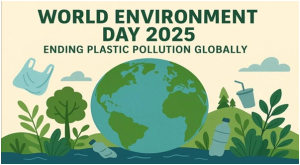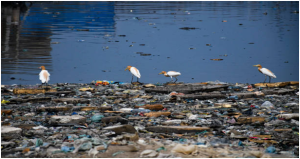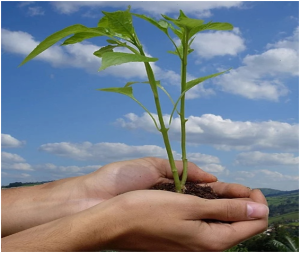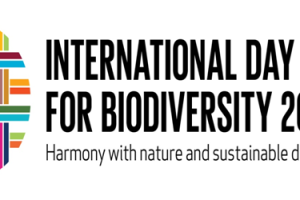
BY DR. RAVINDER PALL SAINI,
INDIAN FOREST SERVICE ( RETIRED)
MEMBER, BOARD OF MANAGEMENT,
FOREST RESEARCH UNIVERSITY,
DEHRADUN.
DEHRADUN | 5 JUNE 2025

Piloted by the United Nations Environment Programme (UNEP) and convened annually on 5 June since 1973, World Environment Day is the biggest global platform for environmental public outreach and is celebrated by millions of people across the world. In 2024 it is being hosted by Saudi Arabia.
“There is sufficiency in the world for man’s need but not for man’s greed”. ~~~~~~~~~~~~~Mohandas K. Gandhi.
“Nature provides a free lunch, but only if we control our appetites”. ~~~~~~~~William Ruckelshaus, Business Week, 18 June 1990.

Theme for 2025:
The theme for World Environment Day 2025 is “Putting an End to Plastic Pollution,” aiming to address the issue of plastic pollution globally.
This theme aligns with the broader goal of ending plastic pollution, as highlighted by the United Nations Environment Programme (UNEP).
The theme focuses on ending plastic pollution, emphasizing the need for urgent global action to reduce plastic waste and protect ecosystems. It isn’t just a warning—it’s a call to action to transform how the world produces, consumes, and disposes of plastics.
Host Country: The Republic of Korea, specifically Jeju Province, will host the global celebrations.
Significance: World Environment Day 2025 will spotlight the growing scientific evidence on the impacts of plastic pollution and drive momentum towards refusing, reducing, reusing, recycling, and rethinking plastics use.
Initiatives: Various organizations are launching campaigns to support the theme, such as the Navi Mumbai Municipal Corporation (NMMC) and Western Railway, which are implementing city-wide plastic and e-waste recycling.

History of World Environment Day:
World Environment Day is commemorated across the globe to honour and recognize the importance of nature, environment, and ecology that support all life forms.
Founded back in 1972 at the Stockholm Conference on Human Environment organized by the United Nations; world environment day is one of the largest events celebrated by over 175 countries across the globe. The inception of world environment day celebration was on 5th June1974, and the event was hosted by the United States with One Earth theme. At a time when the world is suffering the aftermath of Covid – 19 pandemic, it is worthy to shed light on the destruction and obliteration caused by human activities to our environment and the enervating state of our earth.
2010 – 2024
2024 | Our Land. Our Future. We are #GenerationRestoration:
During 2024 the focus was on land restoration, desertification, and drought resilience, under the slogan “Our Land. Our Future. We are #GenerationRestoration”.
2023 | Solutions to Plastic Pollution:
The 2023 edition marked the 50th anniversary of World Environment Day, and focused on solutions to plastic pollution, using the hashtag and slogan #BeatPlasticPollution. With available science and solutions to tackle the problem, governments, companies and other stakeholders must scale up and speed actions to solve this crisis. This underscores the importance of this World Environment Day in mobilizing transformative action from every corner of the world. A resolution was adopted in 2022 at the United Nations Environment Assembly to develop a legally binding instrument on plastic pollution, including in the marine environment, with the ambition to complete the negotiations by end of 2024.

2022 | Only One Earth:
The World Environment Day 2022 global campaign #OnlyOneEarth calls for transformative changes to policies and choices to enable cleaner, greener, and sustainable living in harmony with nature. It will focus on the need to live sustainably in harmony with nature, and our possibilities for shifting to a greener lifestyle through both policies and individual choices. “Only One Earth” was the motto for the 1972 Stockholm Conference. 50 years on, the motto is as pertinent as ever – this planet is our only home, and humanity must safeguard its finite resources.

2021 | Ecosystem Restoration:
Launch of the UN Decade on Ecosystem Restoration. A call for the protection and revival of ecosystems all around the world, for the benefit of people and nature. It aims to halt the degradation of ecosystems and restore them to achieve global goals.
Only with healthy ecosystems can we enhance people’s livelihoods, counteract climate change, and stop the collapse of biodiversity.

2020 | Time for Nature:
A call to action to combat the accelerating species loss and degradation of the natural world. One million plant and animal species risk extinction, largely due to human activities. Recent events, from bushfires in Brazil, the United States and Australia to locust infestations across East Africa – and now, a global disease pandemic – demonstrate the interdependence of humans and the webs of life in which they exist. Nature is sending us a message.
2019 | Beat Air Pollution:
A call for action to combat one of the greatest environmental emerging challenges of our time. Often you can’t even see it, but air pollution is everywhere and affects your health from head to toe. With every breath, you are probably sucking in tiny particles that attack your lungs, heart, and brain.

2018 | Beat Plastic Pollution:
The aim was for people to strive and change their everyday lives to reduce the heavy burden of plastic pollution. People should be free from the over-reliance on single- use or disposables, as they have severe environmental consequences. In addition, we should liberate our natural places, our wildlife, and our own health from plastics.
2017 | Connecting Nature to People:
In the city and on land, from the poles to the equator, it encourages worldwide awareness for the protection of our environment.
2016 | Go Wild for Life:
The campaign aimed to reduce and prevent the illegal trade in wildlife.

2015 | Seven Billion Dreams:
One Planet. Consume with Care:
This was the slogan picked through a voting process on social media.
2014 | International Year of Small Islands Developing States (SIDS):
The UN General Assembly aimed to highlight the development challenges and successes of the SIDS, focusing on global warming and its impact on ocean levels.
The slogan was “Raise your voice not the sea level” for this year.
2013 | Think. Eat. Save:
The campaign addressed the huge annual food waste and loss. With the amount added together, it would release a large quantity of food as well as reduce carbon footprint. The theme also aimed to empower people to make informed choices about the food they eat to reduce the overall ecological impact due to the worldwide production of food.

2012 | The Green Economy:
The campaign invited people to examine their activities and lifestyle and see how the concept of a “Green Economy” fit into it.
2011 | Forests: Nature at Your Service:
Activities were organized with clean-ups, concerts, exhibits, film festivals, community events, tree plantings and much more.
2010 | Many Species. One Planet. One Future:
Celebrating the diversity of life on Earth as part of the 2010 International Year of Biodiversity.
Obligation To Participate:
Time is running out, and nature is in emergency mode. To keep global warming below 1.5°C this century, we must halve annual greenhouse gas emissions by 2030.
Without action, exposure to air pollution beyond safe guidelines will increase by 50 per cent within the decade and plastic waste flowing into aquatic ecosystems will nearly triple by 2040.
Earth’s Biodiversity:
Biodiversity underlines life on Earth and implies the variety found in biota from genetic makeup of plants and animals to our cultural diversity on earth.
Importance of Biodiversity:
People depend on biodiversity in their daily lives, in ways that are not always apparent or appreciated. Human health ultimately depends upon ecosystem products and services (such as availability of fresh water, food, and fuel sources) which are requisite for good human health and productive livelihoods. Biodiversity loss can have significant direct human health impacts if ecosystem services are no
longer adequate to meet social needs. Indirectly, changes in ecosystem services affect livelihoods, income, local migration and, on occasion, may even cause political conflict.
Additionally, biophysical diversity of microorganisms, flora and fauna provides extensive knowledge which carries important benefits for biological, health, and pharmacological sciences. Significant medical and pharmacological discoveries are made through greater understanding of the earth’s biodiversity. Loss in biodiversity may limit discovery of potential treatments for many diseases and health problems.
Facts About Plastic Pollution:
The 2025 day is focusing on ending plastic pollution, emphasizing the need for urgent global action to reduce plastic waste and protect ecosystems.
Such action and leadership are vital as we face a worrying intensification of the triple planetary crisis: the crisis of climate change, the crisis of nature and biodiversity loss, and the crisis of pollution and waste. This crisis is placing the world’s ecosystems under assault.
UNEP Executive Director Inger Andersen urged people around the world to join the effort to end plastic pollution, which she said “impacts every person and every ecosystem on this planet.
“That pollution creeps into our bodies through the food we eat, the water we drink and even the air we breathe,” she said in a video message. “So, on World Environment Day, let’s all recommit to beating plastic pollution, once and for all.”
World Environment Day in 2025 will focus on ending plastic pollution. The Republic of Korea will host the global celebrations.
For decades, plastic pollution has seeped into every corner of the world, leaching into the water we drink, into the food we eat, and our bodies. While plastic pollution is a major concern, it is also one of the most fixable of today’s environmental challenges, with some obvious solutions at hand.
World Environment Day joins the UNEP-led #BeatPlasticPollution this year to mobilize communities worldwide to implement and advocate for solutions. World Environment Day will spotlight the growing scientific evidence on the impacts of plastic pollution and drive momentum to refuse, reduce, reuse, recycle, and rethink plastics use. It will also reinforce the global commitment made in 2022 to end plastic pollution through a global plastic pollution treaty.
Plastic pollution exacerbates the deadly impacts of the triple planetary crisis: the crisis of climate change, the crisis of nature, land and biodiversity loss, and the crisis of pollution and waste. Globally, an estimated 11 million tonnes of plastic waste leak into aquatic ecosystems each year, while microplastics accumulate in the soil from sewage and landfills, due to the use of plastics in agricultural products. The annual social and environmental cost of plastic pollution ranges between US$300 billion and US$600 billion.
This year’s World Environment Day observance comes as countries make progress towards securing a global treaty to end plastic pollution, including in the marine environment. In November 2024, the Republic of Korea hosted the fifth session of negotiations to develop a plastic pollution treaty. The second part of the session will take place from 5 to 14 August in Geneva, Switzerland.
Major areas of concern still persisting and requiring actions:
Desertification:
Desertification is defined as land degradation in arid, semi-arid, and dry sub-humid areas resulting from various factors, mostly climatic variations, and human activities (UNCCD, 1994). Although the term can include the encroachment of sand dunes on land, it does not refer to the expansion of existing deserts. It occurs, however, because dryland ecosystems, which cover over one-third of the world’s land area, are extremely vulnerable to overexploitation and inappropriate land use. In the past decades, the range and intensity of desertification have increased, reaching approximately 30 to 35 times the historical rate and the risks from desertification are
projected to increase due to climate change (IPCC, 2019). While being a hard process to quantify, desertification is characterized by declining vegetation productivity, reduced agricultural productivity and biodiversity loss (IPCC, 2019).
According to the IPCC, the major human drivers of desertification interacting with climate change are the expansion of croplands, unsustainable land management practices and increased pressure on land from population and income growth. On the other hand, desertification exacerbates climate change through several mechanisms such as changes in vegetation cover, sand and dust aerosols and greenhouse gas fluxes.
Drought:
Meteorologically, drought is defined as a prolonged absence or marked deficiency of precipitation that can be characterized as a period of abnormally dry weather with a sufficiently prolonged lack of precipitation as to cause a serious hydrological imbalance (WMO, 1992). Other definitions include impacts like hydrological imbalances that adversely affect land resource productions systems (UNCCD, 1994; Article 1). Put into other words, drought is a climatic phenomenon that can occur almost anywhere in the world when there is a significant decrease in water availability (atmospheric, surface, soil, or groundwater) over a period of weeks to years. Climate change is increasing the frequency and/or magnitudes of droughts in many regions of the world (IPCC, 2021).
Droughts are among the greatest threats to sustainable development, especially in developing countries, but increasingly so in developed nations too. In fact, forecasts estimate that by 2050 droughts may affect over three-quarters of the world’s population. The number and duration of droughts has increased by 29 percent since 2000, as compared to the two previous decades (WMO 2021). When more than 2.3 billion people already face water stress, this is a huge problem.
The UN Convention to Combat Desertification’s 2022 report Droughts in Numbers finds that the African continent has been the most impacted by droughts in the past century, with over 300 episodes and bearing an important death and economic toll around the world. Projections indicate that by 2050, droughts may affect over three- quarters of the world’s population, and an estimated 4.8-5.7 billion people will live in areas that are water-scarce for at least one month each year, up from 3.6 billion today. Up to 216 million people could be forced to migrate by 2050, largely due to drought in combination with other factors including water scarcity, declining crop productivity, sea-level rise, and overpopulation.
Land Degradation and Restoration:
The Intergovernmental Science-Policy Platform on Biodiversity and Ecosystem Services (IPBES) defines land degradation as “the many human-caused processes that drive the decline or loss in biodiversity, ecosystem functions or ecosystem services in any terrestrial and associated aquatic ecosystems”, and restoration as “any intentional activity that initiates or accelerates the recovery of an ecosystem from a degraded state”. Land degradation affects ecosystem functions worldwide disrupts rainfall patterns, exacerbates extreme weather like droughts or floods, and drives further climate change and it relates to instability, which drives poverty, conflict, and migration.
On the other hand, land restoration is the ecological process of restoring a natural and safe landscape for humans, wildlife, and plant communities (UNCCD). Through land restoration, it is possible to reinstate the land’s function to store carbon, to prevent droughts and floods and increase soil productivity. Land restoration can bring economic benefits amounting to USD 30 for every dollar invested in restoration (UNEP, 2021). Restoration boosts livelihoods, lowers poverty and builds resilience to extreme weather.
Restoration increases carbon storage and slows climate change. Restoring just 15 per cent of land and halting further conversation could avoid up to 60 per cent of expected species extinctions.
“We never know the worth of water till the well is dry”. ~~~~~~~Thomas Fuller, Gnomologia, 1732
(Sources: UNEP and UN Geneva Environment Network)

Advertisement:




























Add Comment